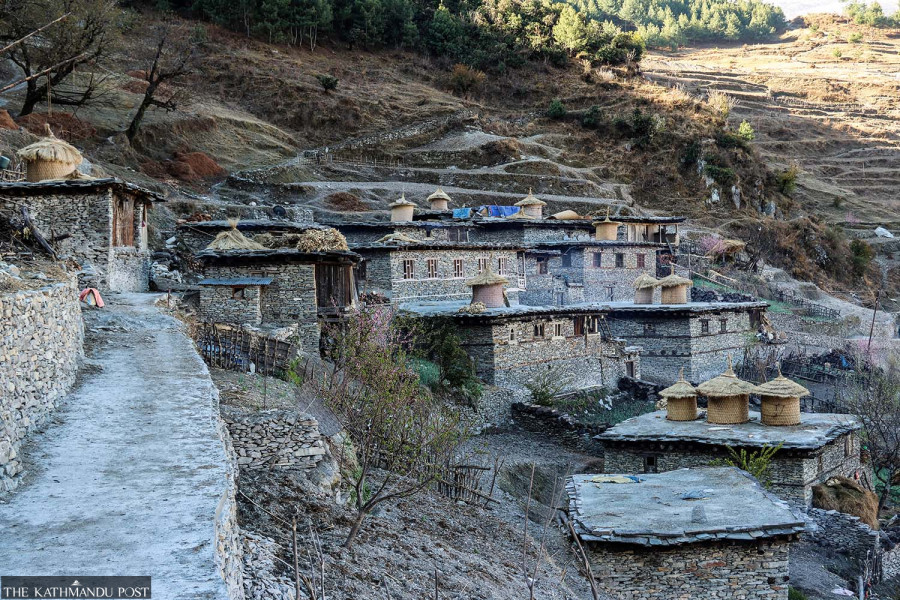Life & Style
Disappearing Himalayan architecture
As modernity rushes in, the construction of traditionally styled houses in East Rukum has decreased significantly.
Mahesh KC
When looking around the settlements of Bhume and Putha Uttarganga villages in East Rukum, here’s what you will see. A two-story traditional house made of mud, wood in between, strong roof and coated with kamero maato (white clay). There’s cattle on the ground floor, housing on the first floor and corn on the roof.
80-year-old Badri Pun of Putha Uttarganga, Ward 1, Maikot remembers every corner of his house which was built 70 years ago. He says that the ground floor of the cattle enclosure is called arbun in Magar Kham language, the first floor is called armibas and the roof is called gagala. Pointing towards a bhakari (large bamboo mat used to store crops) placed in the hood, he says, “In our language, we call this a dhokro.”
Pun was 10 years old when the house was built. Though the house was built in the 1960s, he thinks it still looks like it was built just yesterday. “My parents built a life for themselves in this house. They have passed away, but the house is still the same,” says, adding that he believes that these traditional houses last up to 100 years.
Similar traditional houses that were built decades ago can be found in Maikot. Half-stone half-mud houses, locally called thare ghar, can be seen in different parts of Putha Uttarganga, including Tak, Sera, Kol and Rangsi. Even more so in Bhume’s Kakri, Lukum, Khabang, Mahat and Morbang.
Regarding the uniform look of houses in the area, Veeramaya Budha from Mahat says, “While constructing these houses here, we build the walls mostly with stone and mud. Then we add a roof to the front and build another floor at the back. Finally, we build another roof from stone for the first floor.” A bhakari is always on the roof.
Kamal Sirpali of Putha Uttarganga, Ward 2, Pelma says that locals used to build houses by bringing stones from nearby stone quarries and use that with diyar salla (pine) wood. “When making a roof, the wood is placed, chirpat (wooden planks) is spread over it and soil is placed on top. The roof is strong because we add kamero maato on top and strengthen it with wooden sticks.” Roofs made this way are durable and keep the houses warm in winter and cool in summer. “We consider these houses big assets as they last for two to three generations.”
Balman Pun, a carpenter from Pelma, says these traditional houses have a neat and cosy look to them and can be built at a cost of Rs500,000 to Rs800,000, depending on their sizes. According to him, the cost of building a house has almost doubled in the last decade. As there is a shortage of stone and wood, the residents of this area have started constructing houses that are more modern in architecture and use corrugated roofing sheets that are easy to lay on the roof. Putha Uttarganga, Arjal Ward President, Sur Bahadur BK, says that because of inflation, the decrease in income and increase in expenses, residents of East Rukum haven’t been building houses these days.
These thare ghars are a distinctive feature of rural life in East Rukum. But people have started to abandon the traditional style. The older generation is worried that these traditional houses will eventually disappear as young carpenters and woodworkers from the area aren’t learning the required skills. Bharti Nepali of Bhume, Ward 5 says that the skills have not been passed down. “It is difficult to find young builders who can construct traditional houses,” she exclaims.
Another Maikot resident Vishnu states that he has been trying to discourage the use of corrugated roofing sheets for over a decade now, out of concern that the original form would be lost again. However, he complains that his efforts won’t have much impact without the support from the local government. “Traditional houses used to attract a lot of tourists to our village. Now, we won’t even have that. If the government does not make a plan for its protection soon, only the remains of the old houses will be left behind in a few years,” says Vishnu.




 10.12°C Kathmandu
10.12°C Kathmandu








%20(1).jpg&w=300&height=200)

